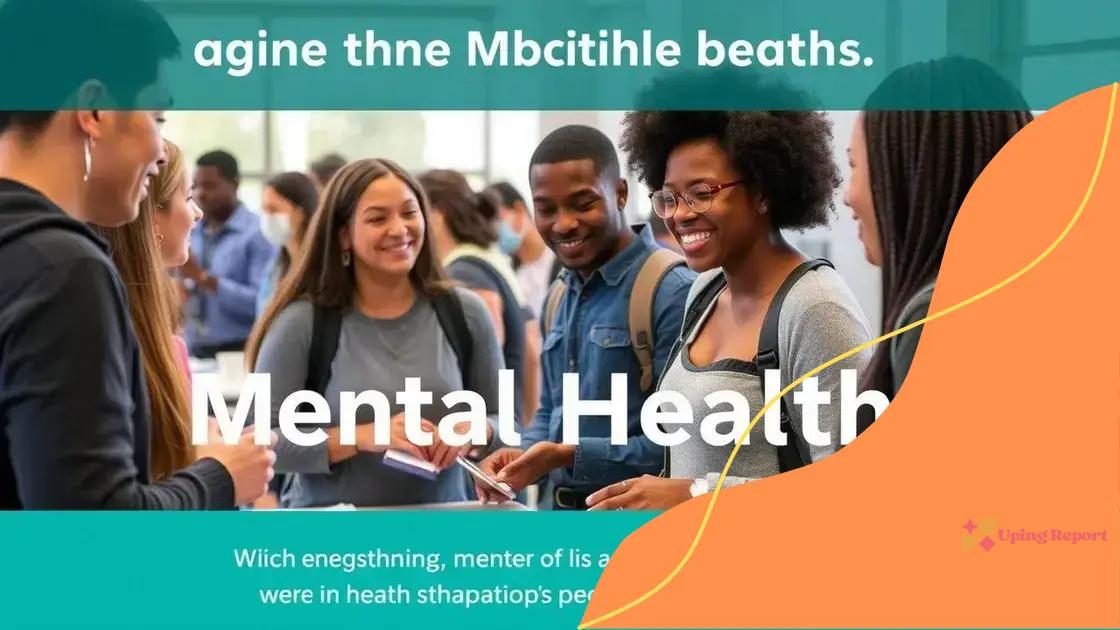Student mental health initiatives enhancing well-being

Student mental health initiatives are crucial for fostering a supportive environment, enhancing well-being, and encouraging open discussions about mental health among students through community involvement and targeted programs.
Student mental health initiatives are becoming increasingly vital in our educational landscapes. Have you ever wondered how these programs can profoundly impact students’ lives? In this article, we will delve into their importance and explore various strategies for effective implementation.
Understanding the importance of mental health in students
Understanding the importance of mental health in students is crucial for their overall success and well-being. Mental health can significantly affect academic performance, social interactions, and personal growth. It’s important to recognize that students face a variety of stressors, from academic pressures to social challenges.
Why Mental Health Matters
When students are mentally healthy, they are more likely to succeed in their studies. They can focus better, participate more actively in class, and make stronger connections with peers. Furthermore, good mental health helps students communicate their needs and cope with challenges effectively.
Common Mental Health Issues
Several mental health issues frequently affect students:
- Anxiety: This can come from exam stress, social situations, or future uncertainties.
- Depression: Feelings of sadness and hopelessness can overshadow a student’s daily life.
- Burnout: High academic demands can lead to emotional exhaustion and decreased motivation.
Addressing these challenges is essential. Schools can create environments where students feel safe to express their feelings and seek help. Providing resources like counseling and support groups can make a significant difference.
Creating Awareness
Raising awareness about mental health in schools is vital. Students should learn that it’s okay to talk about their feelings and ask for help. Programs focusing on mental health education can empower students with knowledge and resources.
Creating supportive communities within schools can also help. Teachers, parents, and students should work together to foster an environment where everyone feels valued and heard. This support network can enhance mental well-being and promote resilience in students.
Key mental health initiatives on campuses
Key mental health initiatives on campuses play a vital role in supporting students’ well-being. These programs aim to create a culture where mental health is prioritized and students feel comfortable seeking help.
Awareness Campaigns
Awareness campaigns are essential for educating students about the importance of mental health. By promoting seminars and workshops, universities can inform students about available resources. Campaigns can also help reduce the stigma associated with mental health issues.
Counseling Services
Many campuses offer free or low-cost counseling services. These services provide students with a safe space to talk about their feelings and challenges. Counselors can guide students through tough times and help them develop coping strategies.
- One-on-one counseling sessions.
- Group therapy options for shared experiences.
- Emergency support services available 24/7.
Having accessible counseling services ensures that students receive timely support. It’s important for students to know they are not alone and that help is available whenever needed.
Peer Support Programs
Peer support programs can enhance the mental health landscape on campuses. Trained student volunteers are equipped to provide support to their peers. This approach can foster a sense of community and encourage students to open up about their struggles.
Workshops and Training
Hosting workshops that focus on stress management and resilience can empower students. These skills help them navigate academic and personal challenges more effectively.
Additionally, training staff and faculty on recognizing signs of mental health issues can create a more supportive environment. When everyone is informed and engaged, the entire campus can contribute to a culture of well-being.
Strategies to promote student engagement in mental health

Promoting student engagement in mental health initiatives is essential for creating a supportive campus environment. By actively involving students, schools can foster a stronger community focused on well-being.
Creating Inclusive Activities
Engaging students in various activities can spark their interest in mental health. Organizing events like mental health fairs or wellness days can provide information in a fun, interactive way. These events allow students to explore resources available to them while enjoying a sense of community.
Peer-Led Programs
Peer-led programs can be highly effective in increasing engagement. When students lead discussions and workshops, their peers feel more comfortable participating. This informal setting often leads to open conversations about mental health. Schools can train student leaders to facilitate these programs, providing support and resources to help them succeed.
- Workshops on stress relief techniques.
- Mindfulness sessions to improve focus and relaxation.
- Group discussions on finding balance in academics.
Another approach is to encourage students to share their experiences through storytelling. Creating safe spaces for these discussions can normalize talking about struggles and strengths alike.
Utilizing Social Media
Social media channels are powerful tools for reaching students. Schools can use these platforms to share valuable content related to mental health. Posting tips, success stories, and resources can engage students where they already spend their time. Additionally, creating hashtags can help spread awareness and foster community engagement.
Incorporating Mental Health into Curricula
Integrating mental health education into existing curricula can promote awareness and understanding. This can include lessons on managing stress, understanding the importance of self-care, and identifying signs of mental health issues in oneself and others. By making these topics part of their academic experience, students can learn to prioritize their well-being.
Evaluating the effectiveness of mental health programs
Evaluating the effectiveness of mental health programs is essential to ensure that they meet students’ needs. A strong evaluation process helps institutions understand what works and what needs improvement.
Setting Clear Goals
To effectively evaluate a program, clear goals must be established from the beginning. These goals should address what the program aims to achieve, such as increasing student awareness, providing support resources, or improving coping skills. By outlining measurable objectives, schools can assess whether the program is meeting its intentions.
Collecting Data
Data collection is a crucial part of evaluating mental health programs. Schools can gather feedback through surveys, interviews, and focus groups. This information provides valuable insights into students’ experiences and the overall impact of the program.
- Surveys can measure student satisfaction.
- Focus groups offer deeper insights into personal experiences.
- Interviews help assess specific needs and outcomes.
Data can be analyzed to identify patterns and trends, helping to understand how effective the program is in reaching its goals.
Monitoring Outcomes
Monitoring specific outcomes is another key factor in evaluating effectiveness. This can include tracking improvements in student well-being, reductions in reported anxiety or depression levels, and overall engagement in mental health resources.
By comparing data over time, schools can see the long-term effects of their programs. For example, if students report using counseling services more frequently after a program is implemented, this may indicate success.
Making Improvements
Program evaluation is not just about measuring success; it’s also about making necessary improvements. Based on the collected data, schools can adjust their programs to better serve the student population. This might involve offering new resources, changing existing services, or enhancing training for staff who implement these programs.
The role of community in supporting student mental health
The role of community in supporting student mental health is essential. A strong support network can make a significant difference in the lives of students. When individuals come together, they create an environment that promotes well-being and resilience.
Building a Supportive Environment
A supportive community helps students feel valued and understood. This sense of belonging can reduce feelings of isolation, which is crucial for mental health. By fostering connections among students, schools can build a tight-knit community that encourages open discussions about mental health.
Parental Involvement
Parents play a key role in supporting their children’s mental health. By staying informed about school resources and participating in events, they can help create a stronger connection between home and school. Encouraging parents to attend workshops or support groups can provide them with the tools needed to better understand and assist their children.
Peer Support Programs
Peer support programs are an effective way for students to connect with one another. These programs allow students to share their experiences and provide support to each other. Having trained peer mentors can make a huge difference in how students view mental health. They often feel more comfortable discussing their struggles with peers.
- Workshops led by students about mental health awareness.
- Encouraging friendships that focus on support and understanding.
- Creating safe spaces for sharing experiences and advice.
Collaboration with Local Resources
Schools can also work with local organizations and mental health professionals to enhance the support provided to students. This collaboration can result in expanded resources, such as counseling services and workshops on mental wellness. By offering additional support, communities help ensure that students have access to the help they need.
In conclusion, supporting student mental health requires a strong community effort. By building a network of resources, promoting peer support, and involving families, schools can create an environment where students feel safe and valued. When students engage with these initiatives, they are more likely to thrive academically and socially. Remember, mental health is just as important as physical health, and together we can foster a positive atmosphere for everyone.
FAQ – Frequently Asked Questions about Student Mental Health Initiatives
What role does community play in student mental health?
Community involvement provides support, fosters relationships, and creates an environment where students feel safe discussing their mental health.
How can parents support their children’s mental health?
Parents can attend school events, encourage open discussions, and ensure their children utilize available mental health resources.
What are peer support programs?
Peer support programs involve students helping each other by sharing experiences and encouragement, often making mental health discussions more relatable.
How can schools evaluate the effectiveness of mental health programs?
Schools can assess program effectiveness by collecting data through surveys, monitoring outcomes, and setting clear goals to guide evaluations.
